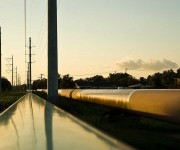A pipeline in Texas, the ultimate destination of Keystone XL.Photo: Ray BoddenCross-posted from Climate Progress.
Construction and operation of the Keystone Pipeline system will continue to meet or exceed world-class safety and environmental standards.
That was a statement from TransCanada CEO Hal Kvisle in June 2010 about the commissioning of the company’s new Keystone pipeline, built to bring Canadian tar-sands crude from Alberta to refineries in the Midwest. One year later, the company has seen 12 oil spills from its brand new, state-of-the art pipeline — with one “six-story geyser” dumping 21,000 gallons of oil in North Dakota.
Today, TransCanada is looking to build another pipeline, Keystone XL, to bring tar-sands crude all the way down to the Gulf of Mexico. The company is again selling it as “the safest pipeline in the U.S.”
Company executives were in Montana Tuesday, trying to reassure residents who are concerned about the environmental impact of another pipeline after Exxon spilled 1,200 barrels of oil into the Yellowstone river in early July:
TransCanada’s proposed Keystone XL Pipeline will be the safest crude oil pipeline built in America, officials of the Calgary-based company told reporters Tuesday during a stop in Billings.
“A very high degree of safety” has been engineered into the project, said [Engineer and Director of the Keystone XL project Les] Cherwenuk. The company has been subjected to “regulated standards that have never been required of any operation constructing a new liquid pipeline,” he said.
There will be “minor” environmental disruption, company officials acknowledge. But they stressed that the disruptions are far outweighed by security and economic factors.
However, the agency tasked with reviewing the environmental impact of the project, the Environmental Protection Agency (EPA), has twice said the disruption would be more than just “minor.”
Last month, the EPA criticized the lack of information about the the Keystone XL pipeline, saying TransCanada and the State Department needed to produce more detail on “the purpose and need for the project, potential greenhouse gas emissions associated with the project, air pollutant emissions at the receiving refineries, air pollutant emissions at the receiving refineries, pipeline safety/spill response, potential impacts to environmental justice communities, wetlands and migratory birds.”
In other words, every possible environmental impact of the pipeline.
Regarding the “purpose and need for the project,” two studies have shown that there is already enough pipeline capacity to handle tar-sands crude coming out of Alberta. From a report [PDF] prepared by Ensys Energy for the Department of Energy:
In every scenario studied, with or without KXL, the excess cross-border pipeline capacity persists until after 2020. In scenarios where high pipeline capacity to the British Columbia coast — and thence Asia — is assumed built, the excess cross-border capacity into the U.S.A. is projected as continuing until 2025 or even 2030.
And another report [PDF] from the Canadian government came to the same conclusion:
When evaluating the need for new infrastructure, the Board considers the capability of existing infrastructure to meet current and future market requirements. The evidence indicates that should the Keystone XL project proceed, there may for some time be physical excess pipeline capacity for western Canadian crude oil exports.
On the greenhouse-gas emissions front, the EPA points out that tar-sands carbon emissions are “82 percent greater than the average crude refined in the U.S., on a well-to-tank basis.” The local environmental impact is also extensive: the strip mining for bitumen has caused extensive damage to Canada’s boreal forest and creates “dead” water ponds containing mercury, arsenic, cadmium, and hydrocarbons that are so big, they can be seen from space.
Defining what it means to build the “safest” pipeline in the U.S. depends on how you define “safe.”
While TransCanada officials are making the rounds in the Midwest, activists led by Bill McKibben are in Washington, D.C. over the next couple of weeks, protesting the State Department’s expected approval of Keystone XL.



